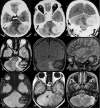Tumour bleed manifesting as spontaneous extradural haematoma in posterior fossa
- PMID: 25008340
- PMCID: PMC4091297
- DOI: 10.1136/bcr-2014-205175
Tumour bleed manifesting as spontaneous extradural haematoma in posterior fossa
Abstract
We report a unique case of primary extradural angiosarcoma of posterior fossa manifesting as extradural haematoma in a 12-year-old boy who presented with acute onset headache, vomiting, nuchal rigidity and altered sensorium. The patient underwent a retromastoid suboccipital craniotomy on emergency basis, and the lesion was excised completely. Histopathology and immunohistochemistry revealed an angiosarcoma, following which radiation therapy was given. The patient showed complete clinical and neurological improvement. At a follow-up of 2 years he is in good health without any sign of regrowth.
2014 BMJ Publishing Group Ltd.
Figures


Similar articles
-
Chronic extradural haematoma of the posterior fossa. Case report.Zentralbl Neurochir. 1988;49(1):12-4. Zentralbl Neurochir. 1988. PMID: 3407365
-
Extradural haematoma of posterior cranial fossa.J Neurosurg Sci. 1993 Mar;37(1):47-51. J Neurosurg Sci. 1993. PMID: 8366368 Review.
-
Posterior fossa extradural hematomas in children: report of nine cases.Childs Nerv Syst. 1993 Jul;9(4):224-8. doi: 10.1007/BF00303574. Childs Nerv Syst. 1993. PMID: 8402704
-
Acute bilateral extradural haematoma of the posterior cranial fossa.Br J Neurosurg. 1997 Dec;11(6):573-5. doi: 10.1080/02688699745763. Br J Neurosurg. 1997. PMID: 11013632 Review.
-
Traumatic epidural haematoma of the posterior fossa in childhood: 16 new cases and a review of the literature.Br J Neurosurg. 2003 Jun;17(3):226-9. doi: 10.1080/0268869031000153071. Br J Neurosurg. 2003. PMID: 14565517 Review.
Cited by
-
Posterior Fossa Acute Extradural Hematoma in Children: Review and Management Guidelines.J Pediatr Neurosci. 2018 Jul-Sep;13(3):289-293. doi: 10.4103/JPN.JPN_86_18. J Pediatr Neurosci. 2018. PMID: 30271459 Free PMC article. Review.
References
-
- Guode Z, Qi P, Hua G, et al. Primary cerebellopontine angle angiosarcoma. J Clin Neurosci 2008;15:942–46 - PubMed
-
- Kanai R, Kubota H, Terada T, et al. Spontaneous epidural hematoma due to skull metastasis of hepatocellular carcinoma. J Clin Neurosci 2009;16:137–40 - PubMed
-
- Hassan MF, Dhamija B, Palmer JD, et al. Spontaneous cranial extradural hematoma: case report and review of literature. Neuropathology 2009;29:480–4 - PubMed
Publication types
MeSH terms
LinkOut - more resources
Full Text Sources
Other Literature Sources
Medical
